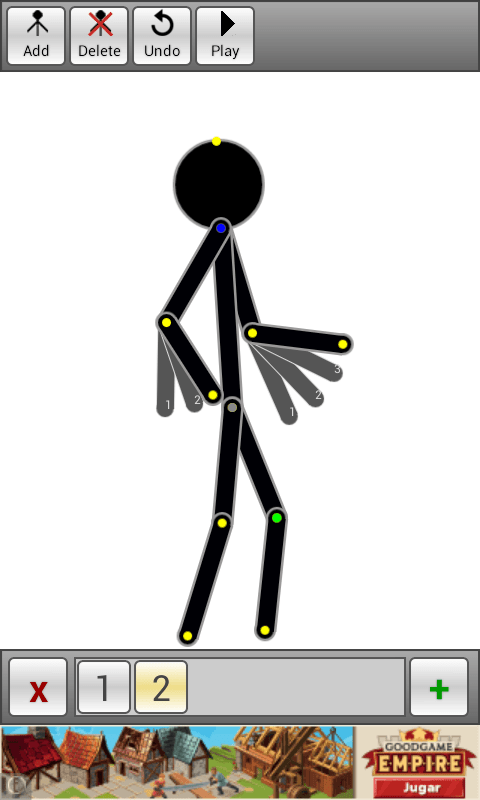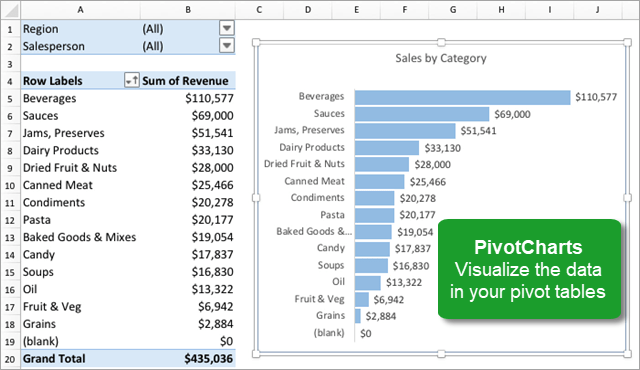As I mention in my post on creating pivot charts, you can’t create pivot charts in Excel for the Mac. It’s, hands down, my greatest aggravation with Excel. Bar none. However, Excel for the Mac has an additional bug that renders any pivot chart created on a PC that includes a report filter utterly useless. You can see the options in the drop-down filter and even select them. In fact, the pivot table (that’s created with every pivot chart) updates. However, your pivot chart will not update. I demonstrate this disappointing failure in this short demo.


Question: In Microsoft Excel 2011 for Mac, I've created a pivot table and now I need to change the data source. How do I change the data source for an existing pivot table? Answer: Click somewhere in the pivot table and the PivotTable tab should appear in the toolbar at the top of the screen. Select the PivotTable tab, click on the Options button and select Change Source from the popup menu. Excel 2016/2019 for Mac have many of the same basic analysis features that are listed above: PivotTables, slicers, charts, and basic import capabilities. They do not yet have Get & Transform or Power Pivot, but we are continually improving Excel on the Mac. Excel for Microsoft 365 for Mac offers some support for Power Query. Re: Power Pivot Excel 2019 Mac @Athira1512.However, the call for Microsoft to Add Power Pivot to Mac Excel is gaining more attention based on the Votes in the link below.
Test For Yourself

Don’t believe me, Excel for Mac users? Go ahead and test it for yourself with the pivot chart in this Excel file.


Pivot Table with Multiple Sheets (Table of Content) Pivot Table with Multiple Sheets; How to Create Pivot Table from Multiple Sheets in Excel? Pivot Table with Multiple Sheets. Most of you know about the pivot tables, it is a very useful tool to get all your data consolidated in one table and get the figures for particular things as required. Pivot Animator for PC – Pivot Animator is a Bring your figures to life by creating a sequence of animation frames! This Freeware Imaging And Digital Photo app, was build by Home Inc. And just, updated to the final version at June, 25th 2019.
Learn More
If you want to learn more about data visualizations that don’t suck, check out my Annielytics Dashboard Course offerings.
Image from troll.me.
Mac's Pivot Engine Lift Plate
In Excel 2011 for mac, a PivotTable is a special kind of table that summarizes data from a table, data range, or database external to the workbook. If you’re PivotTable aficionado, you will be in seventh heaven with the new PivotTable capabilities in Office 2011 for Mac. Here’s how to make a PivotTable:
(Optional) Select a cell in your data range or table.
Choose Data→PivotTable. Alternatively, on the Ribbon’s Tables tab, go to the Tools group and click Summarize with PivotTable.
Choose the data to analyze:
Make choices from the following options:
Location: If you performed Step 1, your table or range is already filled in for you. If you didn’t start with a table or range, you can select a data range or table using the mouse.
Use an External Data Source:Displays the Mac OS X ODBC dialog.
Choose where to put the PivotTable:
New Worksheet: If selected, adds a new sheet to the workbook and places your PivotTable in Cell A1 of the new worksheet.
Existing Worksheet:Choose a cell on your worksheet. The cell will be the upper-leftmost corner of your PivotTable. Make sure there’s enough room so your PivotTable doesn’t overlap existing cell ranges.
Click OK.
Drag field names from the Field Name section at the top to the panes below.
Selecting and deselecting the field names includes or excludes the columns from the pivot table.
Clicking the pop-up buttons within the pivot table displays Filter dialogs appropriate for the data type in your pivot table.
You can filter the Field Name list by typing field names in the search box in the Pivot Table Builder dialog.
Drag fields from one pane to another to generate new pivot table variations.
You can change the column names, calculations, and number formats provided by the PivotTable Builder. There’s a little information button at the right end of each field name in the panels at the bottom of the PivotTable Builder. Click the information button to display the PivotTable Field dialog. The properties displayed are for the field name of the button you clicked:
Pivot Mach 5.5
Field Name (Optional): Type a new field name.
Summarize By: Choose which type of calculation to use.
Show Data As: Select how you want to show the data from the pop-up menu. You can choose from Normal, Difference From, % Of, % Difference From, Running Total In, % of Row, % of Column, % of Total, or Index.
QuickTime is an extensible multimedia framework developed by Apple Inc., capable of handling various formats of digital video, picture, sound, panoramic images, and interactivity.First made in 1991, the latest Mac version, QuickTime X, is currently available on Mac OS X Snow Leopard and newer. Apple ceased support for the Windows version of QuickTime in 2016, and ceased support for QuickTime 7. Quicktime player for mac. Free Apple Mac/OS Classic Version 6.0.3 Full Specs. Now nearly impossible to be found via Apple's website quicktime 6 for Mac OS 9 is accessible via this versiontracker link. Global Nav Open Menu Global Nav Close Menu; Apple; Shopping Bag +. Mac OS X v10.7 Lion; Mac OS X v10.6 Snow Leopard; Mac OS X v10.5 Leopard; Mac OS X v10.4 Tiger; Mac OS X v10.3 and earlier; Mac OS X Technologies; Classic Mac OS (OS9, OS8 & System 7) Photos for Mac; QuickTime; Safari; Front Row.
Base Field and Base Item: If you choose Difference Fromin the Show Data As pop-up menu, choose which fields you’re comparing.
Delete: Removes this field from the PivotTable report.
Number: Displays the Number tab of the Format Cells dialog so you can choose a number format or make a custom number format.
When you select a cell in a PivotTable, look at the Ribbon to find the PivotTable tab, which you click to display all sorts of PivotTable tools. The PivotTable tab is for experts. PivotTable Ribbon offers additional formatting options and still more controls for your PivotTable, but it goes beyond the scope of this book. If you find PivotTables to be useful, then by all means explore the PivotTable Ribbon.

